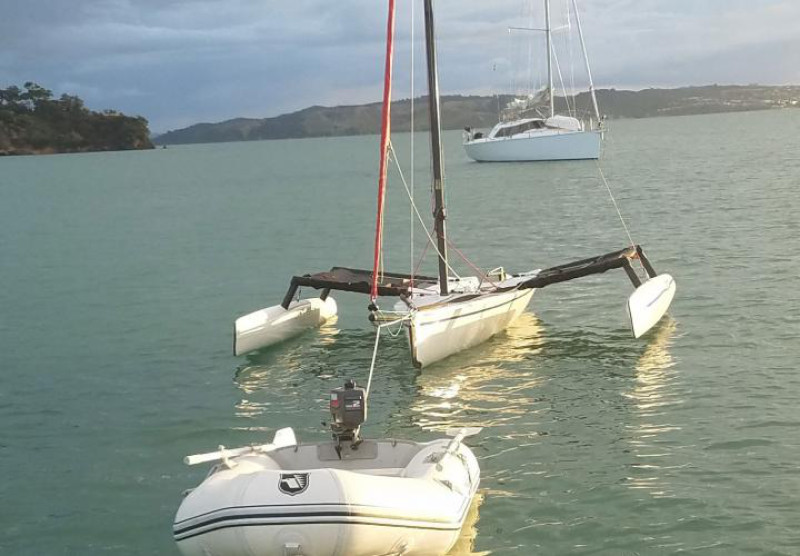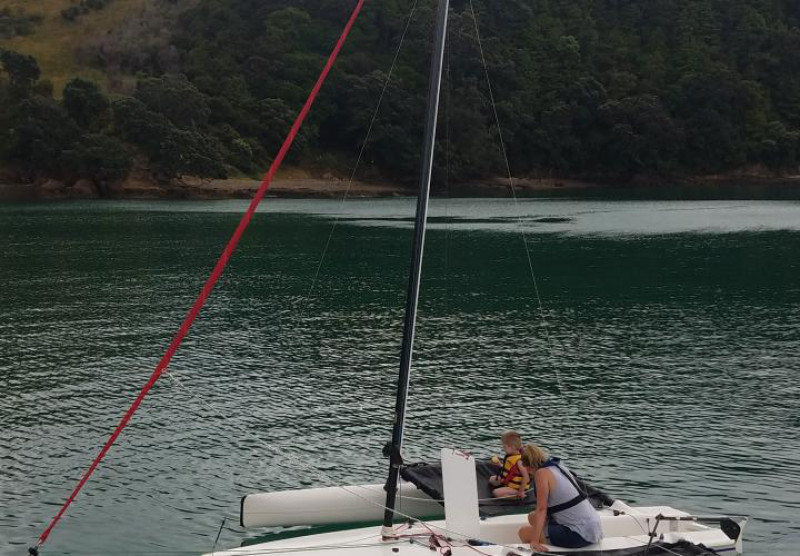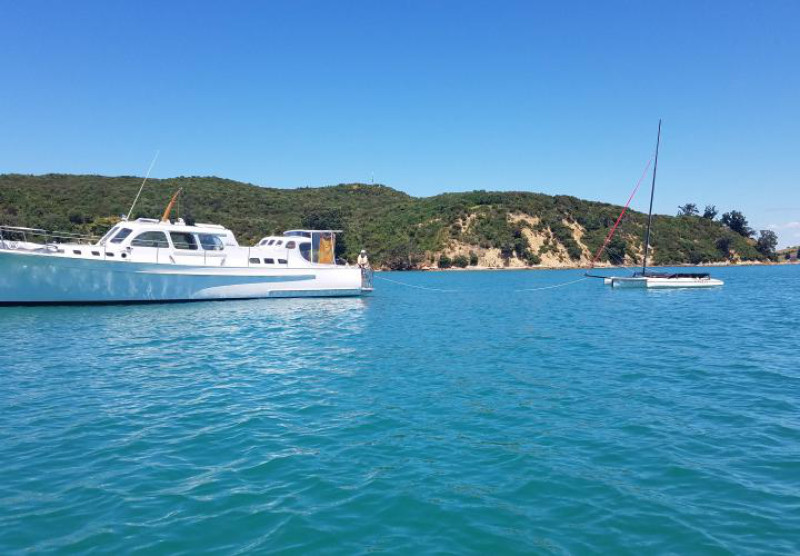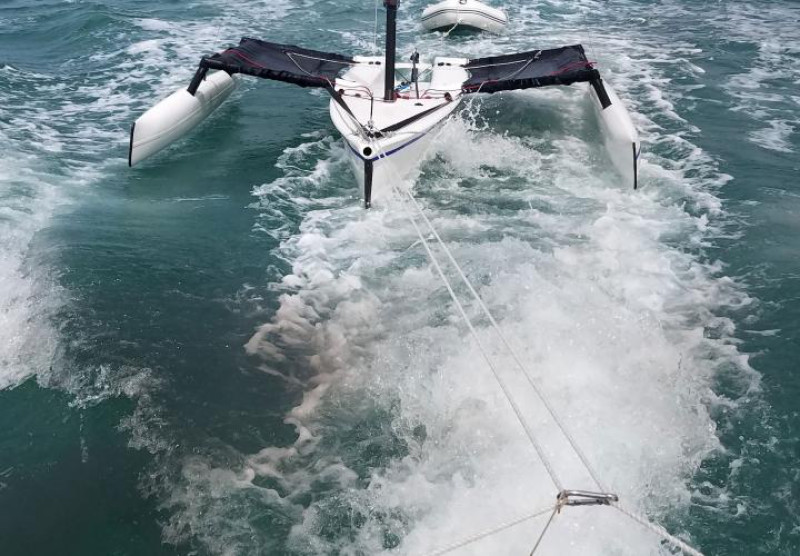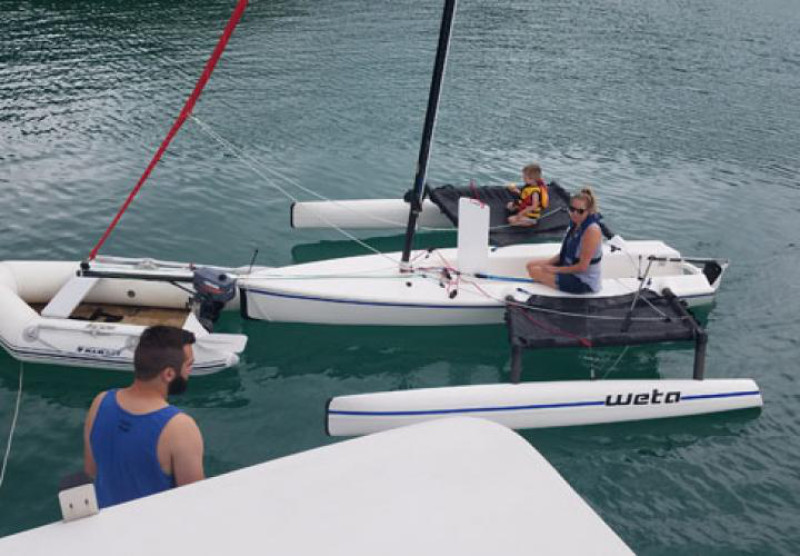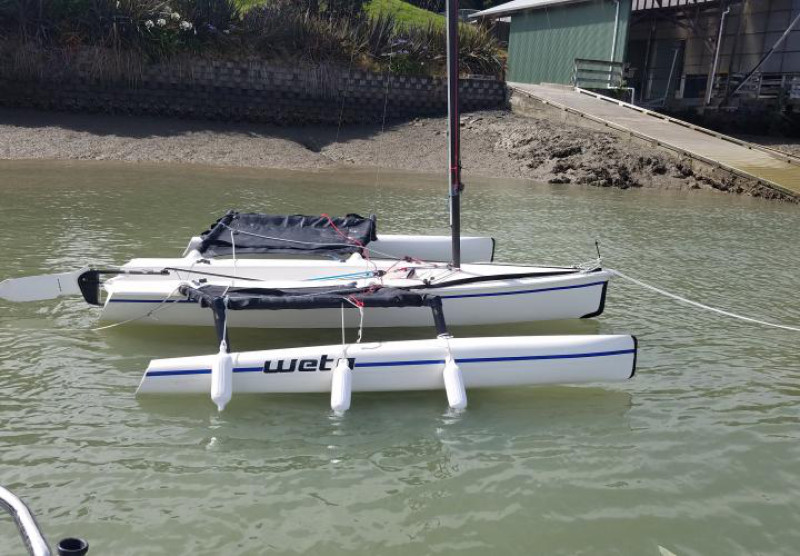
July 13th, 2018
I've always wanted to sail my Weta wherever I wanted, and a trailer makes that possible to a large degree. The ability of this boat to explore harbours and coastal areas, accessible by road and a beach or ramp, has spoiled me for choice as far as it goes. But the places I wanted to do that were places I grew up around as a kid while cruising with family and friends on my dad's yacht, namely the islands and bays around the Hauraki gulf.
Although the Weta is supremely capable of travelling long distances pretty easily, the thought of camping somewhere for any length of time waiting for the weather to change just ain't my idea of a good time.
My solution was to supply my own island with a comfy bunk, hot coffee, (or a cold beer) and good food. And also the means to take family and friends to share it with.
The result was a chance purchase of a slightly neglected classic launch needing some TLC.
After two summer's getting to grips with it all again after a break away from the Xmas cruise scene for a few years, the last summer was a ridiculously good time for a return. The weather gods dished out the goodies this year, some outstanding days and warm water to cool off in.
Towing the Weta with us was something I've been thinking of for a while, I had tried to talk dad into dragging my beat up Hobie 14 around behind his boat when I was a kid. Thinking back, he explained to me the dangers of towing very light and flighty things behind big boats. The chances of my boat running up into the stern of his at pace in a following sea wasn't a thing he longed to see happen. So now I'm slightly more grown up and spent so much time working on my own boat, I totally understand his reticence.
After a chat or three with Roger Kitchen, where he never said it was a crazy idea and gave me some great advice, now was the time.
As fortune would have it, our big boat tops out at around 8.5 knots, and to be honest, I don't know if I would want to tow one much faster than that, although if tied up properly, I can't see why it wouldn't just sit on its haunches and follow along if the lead was short enough to the transom. That is, pretty much sitting on the duckboard.
Set up to tow the Weta is to rig up as usual but without any sails aboard. All halyards run tight and all slack line tidied away. First time out I left the gennaker pole out in case it tried to make us into a kebab.
The initial method was to loop two webbing straps, with loops on either end, about 2 meters long, around the inner ends of port and starboard beams at their strongest point, where they enter the main hull.
The loops are then tied to the tow rope and fed under the dyneema forestay connection. I also tied two lines from the other end of the front beams where they enter the outrigger hulls (amas?). From there I tied them just ahead of where the main tow ropes emerged about half a meter from the bow, running back to the boat and connected to a bridle tied to the tow boats stern cleats to keep her centred. The rudder was on the boat but tied up and bungeed so it didn't move. I was thinking that the rubber dinghy tied to the stern of the Weta would be just the thing to keep her going in a straight line, but as you can see in the video, it didn't work out so good. It was too heavy and looked like it wanted the Weta to weave all over the show. I spent the forty minutes on the way out of the river working on the tow line length and bridle set up, as can be seen with the shackle I was moving up and down the tow line to figure out what was best.
I was lucky to have my boat moored quite far upstream, it gave me time to get myself organised. Some of my original ideas didn't pan out like I wanted and that gave me the chance to watch and learn what was going on with real world testing.
Maybe one of the most important things learned was to attach a drogue to the aft beam of the Weta, where the top rudder pintle is. Mine was in the form of a 1.5 meter length of a really thick braid I found in a locker with some knots tied along it at intervals to create drag, but not be too much of a drag like the inflatable was. I later learned that it was better to tie it upside down on the tramp.
We started out in flat water at about 5 knots, the legal limit around moored areas. I kept it quite close at the beginning to see how much weight was involved. The rope I used was a cheap but new polypropylene that would float and not get chewed up if I reversed. I let it out slowly until it was more or less squatting on the aft wake. Once we powered up to 8 knots, I let the line out to the point of least resistance. It did want to hunt around a bit but the side lines bought her back into line relatively quickly. I sometimes saw the raised rudder catch the water and threaten to twist her around but it never did. The only time it looked possible was when a passing boat threw out a large wake but as long as the tension on the towing line was constant it always came back. However, the inflatable, rather than act as a drogue was just too unpredictable.
Once at anchor, I found the Weta could be a bit of a handful; even with bare mast it still wanted to cuddle up with us. A breeze just made things worse. The answer was to leave the drogue rope connected and, no rudders or centreboard down and, at least while testing, a longish line back to the big boat. The long line gave us some peace of mind but it didn't endear me to the people I was sharing the anchorage with. This was when some real serious discussion occurred over too many drinks in order to refine what we knew, or thought we did.
Next day, first sail. Beautiful day again. Great sail from Man-o-war Bay, Waiheke, over to Pakatoa island and back.
On the return however, we found the wind had gone around, making it a pretty uncomfortable anchorage. Taking sails down and tidying up while tied in a growing sea provided a few more issues, but as long as you were wet already it was do-able.
Before moving this time however I decided to leave the gennaker pole in as it was too hard to remove in the swell. This turned out to be a good thing - the loose loop I had tied around the end of the pole to feed the towing line through allowed the Weta to track even better with no sign of it wanting to hunt around or even look like threatening to turn sideways.
So, that was the method that worked best for us. Webbing to towline to bridle, dinghy on top, no rudder or centreboard so she can be pulled back into line with no resistance, (it'll just skid over the water sideways if need be) and be corrected back into line with the knotted drogue line without strain on anything. Even in the worst conditions we encountered (20+ knots on the nose this summer, easy!) resulted in just the occasional line checks but no drama to speak of.
I did have a bit of an interesting sail on one day off Ponui island. The Weta had been in the water for about a week and sailed maybe 4 or 5 times. I got stuck in a bay, around the corner from our anchorage and out of sight, where the wind came from everywhere and I just couldn't get her to point out to sea again. I got slammed at one point and capsized about 20 meters from a reef reaching out from the leeward end of the bay ; if it wasn't for my mast burying itself in the mud I would have been on it. Had real trouble getting back to horizontal and even more getting to the shore to sort myself out. I emptied the water out of the hull I had flooded and sealed it back up. Had a break, got the boat back in the water and walked her up to windward so I couldn't get stuck back on that reef. While on the beach I couldn't seem to get the bung out of the main hull. It was too tight and I had lost my little sailing tool in the capsize ( as well as my flash new mast top windex). I figured if i couldn't get it off I was pretty watertight already. The next half hour I capsized twice more in virtually the same spot, getting more tired and deciding to call it a day. Roger later informed me that there is a breather hole somewhere in the transom that can let in water when boat is turned turtle, so I'm guessing it was probably half full already after being towed around and lounged on without being checked for a week - lesson learned!
The only other issue was remembering to have a crew member hold the line short when reversing to set the anchor but we just got in the habit.
The Weta was great sailing of the beaches or just as an extra deck to hang out on in the sun or throw kids off when being a swim platform ( as long as you beach it every day or two to check for extra water ballast).
By Myk Ryan
